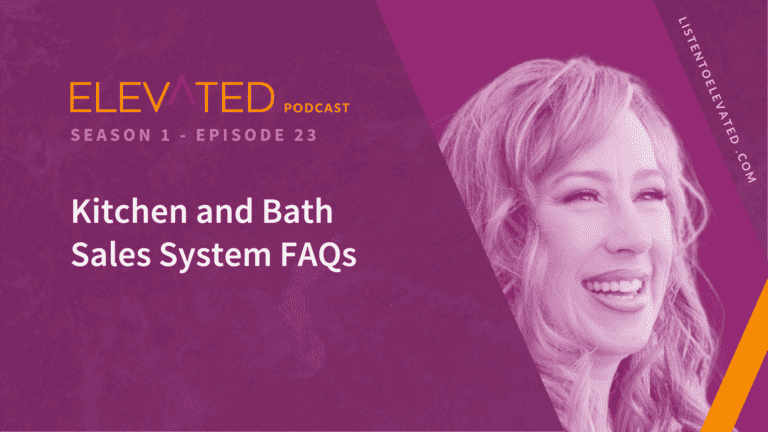Kitchen and Bath Sales System FAQs

In this season of Elevated so far, we’ve been demystifying the idea of a sales system for kitchen and bath businesses, why you need it, how you can use it and in the last couple episodes got into the nitty gritty on how to get your team to embrace the system.
In this episode, I’ll be diving into some of the most frequently asked questions about implementing a sales system for kitchen and bath businesses. Quick sidebar here in case you haven’t caught earlier episodes – a sales system is NOT just software. Certainly software or an app can help power your sales system, but the system itself is the defined, repeatable and scalable process you use to convert people that are interested in your services to paying clients.
Okay, now onto the questions…
How is a sales system different from generating estimates and proposals?
Generating estimates and proposals are steps in your sales process. So a sales system is the larger view of the method used to qualify prospects and take them through a process that includes creating an estimate & proposal. I’ve heard from several kitchen & bath design business owners that estimates & proposals can be a serious pain point in the sales process as they can be very labor intensive, and don’t always result in a sale – so end up eating into profit.
Taking the time to define your sales system can help reduce wasted time & effort on estimates & proposals by qualifying prospective clients earlier in the process. This means you end up generating estimates & proposals only for those prospects that meet the criteria that qualifies them as a likely client, increasing the chances that they’ll become paying clients.
How much does a Sales System for Kitchen and Bath cost?
Yes, this is often one of the first questions that gets asked, and like most critical questions, the answer is… it depends. Don’t worry, I’m not going to leave you hanging. Let’s dig in further and get a real answer.
First off, you can create a fully functional sales system just using a Google or Word document to capture the process and a Google Sheet or Excel document to capture information on the companies and people you talk to. In that case, there wouldn’t be any additional hard cost to the system as you already are paying for that software. Of course there’s the soft cost of time and effort to define, setup & use the system.
My position in regards to these soft costs is that the time & effort investment to create the system pays dividends every time someone uses the system, because without it the customer data is who-knows-where and it is likely taking double or triple the time to do anything if you have to chase down information. Not to mention the lost opportunity cost when a hot lead falls through the cracks because there isn’t a system to track it.
Now, to take this further, utilizing Customer Relationship Management software (CRM) tailored for a kitchen and bath sales system often involves a per-user cost. I cover setting up a CRM in-depth in episode 10, so check that out for all the details. In the interest of finishing out the answer to this question, there are many CRM apps that have a free tier to get you started like Hubspot, Zoho and Streak.
Once you get to the point of needing the paid features, the cost can range from $15 to $300+ per user per month, depending on the CRM you choose. While that can seem like a hefty investment, it is always useful to consider the context of what each deal is worth to the business and the cost of the sales person’s time. If a CRM can save them even an hour per workday, so 5 hours a week, with an average hourly rate of $30/hr, that would save $150 per week, per sales person. In that case, the math of paying up to $150/month per user for a CRM to save $630/month in wage costs and likely make them the sales person more effective at closing deals really adds up.
Which CRM should I choose?
Ah yes – another probing question that gets the standard answer… it depends. When clients ask me about choosing the right app or software, I tell them the right one is the one that actually gets used. Yes, that really is my top criteria for software evaluation. But knowing if you’ll use it usually comes after you’ve selected 1 or 2 to try, so to get to that point, here are the other selection criteria to use:
- Does it have the functionality & features you need? Yes, you’ll need to do a bit of prep work before shopping around to figure out what specific features are must-haves for your business.
- Does it work with the other software & apps you already use? Yup, more prep work. Be sure to have a list of software & apps you use so you can check for integrations.
- Are there tutorials and/or communities of users you can access for learning? Newer software solutions may not have large communities yet, but the existence of robust learning libraries and communities of users means it will be easier to get up and running and get your questions answered.
- Is the paid tier in your budget? Even if you’ll be starting with the free version, ensure that the paid tier is in the ballpark for you as you don’t want to adopt the software and then need to change applications later because the paid version isn’t aligned with your budget.
That covers the top 3 most frequently asked questions about sales systems. If you’ve got another question you want answered, send me a message on social or submit your question on our website.
In the next episode I’ll walk you through a Sales System Health Check – what it is and why you need it. Make sure to subscribe so you don’t miss it!

